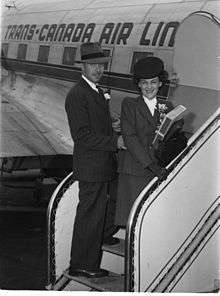Honeymoon
A honeymoon is a vacation taken by newlyweds shortly after a wedding to celebrate their marriage. Today, honeymoons are often celebrated in destinations considered exotic or romantic.
History

In Western culture, the custom of a newlywed couple going on a holiday together originated in early 19th century Great Britain. Upper-class couples would take a "bridal tour", sometimes accompanied by friends or family, to visit relatives who had not been able to attend the wedding.[1] The practice soon spread to the European continent and was known as voyage à la façon anglaise (English-style voyage) in France from the 1820s onwards.
Honeymoons in the modern sense—a pure holiday voyage undertaken by the couple—became widespread during the Belle Époque,[2] as one of the first instances of modern mass tourism. This came about in spite of initial disapproval by contemporary medical opinion (which worried about women's frail health) and by savoir vivre guidebooks (which referred the public attention drawn to what was assumed to be the wife's sexual initiation). The most popular honeymoon destinations at the time were the French Riviera and Italy, particularly its seaside resorts and romantic cities such as Rome, Verona or Venice. Typically honeymoons would start on the night of the marriage, with the couple leaving midway through the reception to catch a late train or ship. However, in the 21st century, many couples will not leave until 1–3 days after the ceremony and reception. In Jewish traditions, honeymoons are often put off seven days to allow for the seven nights of feasting if the visits to friends and family cannot be incorporated into the trip.
Etymology
The honeymoon was originally the period following marriage, "characterized by love and happiness", as attested since 1546.[3] The word may allude to "the idea that the first month of marriage is the sweetest."[4]
"The first month after marriage, when there is nothing but tenderness and pleasure" (Samuel Johnson); originally having no reference to the period of a month, but comparing the mutual affection of newly married persons to the changing moon which is no sooner full than it begins to wane; now, usually, the holiday spent together by a newly married couple, before settling down at home.
Today, honeymoon has a positive meaning, but originally it may have referred to the inevitable waning of love like a phase of the moon. In 1552, Richard Huloet wrote:
Hony mone, a term proverbially applied to such as be newly married, which will not fall out at the first, but th'one loveth the other at the beginning exceedingly, the likelihood of their exceadinge love appearing to aswage, ye which time the vulgar people call the hony mone.
— Abcedarium Anglico-Latinum pro Tyrunculis[3]
A fanciful 19th-century theory claimed that the word alludes to "the custom of the higher order of the Teutones... to drink Mead, or Metheglin, a beverage made with honey, for thirty days after every wedding",[5][6] but the theory is now rejected.[7][8]
In many modern languages, the word for a honeymoon is a calque (e.g. French lune de miel) or near-calque of the English.
Effects
One 2015 scholarly study concluded that going on a honeymoon is associated with a somewhat lower risk of divorce, regardless of how much or little is spent on the honeymoon itself.[9] However, high spending and incurring significant debt on other wedding-related expenses such as engagement rings and wedding ceremonies is associated with a high risk of divorce.[9]
See also
- Babymoon
- Bride kidnapping
References
- ↑ Ginger Strand (January 2008). "Selling Sex in Honeymoon Heaven". The Believer.
- ↑ Sylvain Venayre (June 2007). "Le Temps du voyage noces". L’Histoire (321): 57. ISSN 0182-2411.
- 1 2 Oxford English Dictionary, s.v.
- ↑ Merriam-Webster Dictionary s.v.
- ↑ William Pulleyn, The Etymological Compendium, 1853, p. 178
- ↑ Ebenezer Cobham Brewer, Dictionary of Phrase and Fable, 4th edition, 1870?, p. 413
- ↑ Brohaugh, Bill (2008). Everything you know about English is wrong. Naperville, Ill.: Sourcebooks. p. 92. ISBN 9781402211355.
- ↑ Monger, George P. (2013). Marriage customs of the world : an encyclopedia of dating customs and wedding traditions (Expanded 2nd ed.). Santa Barbara, Calif.: ABC-CLIO. p. 352. ISBN 9781598846645. Retrieved 1 October 2014.
- 1 2 Francis-Tan, Andrew; Mialon, Hugo M. (2014-09-15). "'A Diamond is Forever' and Other Fairy Tales: The Relationship between Wedding Expenses and Marriage Duration". Rochester, NY. doi:10.2139/ssrn.2501480.